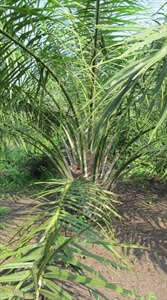- Widespread distribution. Asia, Southeast Asia, Oceania. On oil palm, coconut and many other palms and trees. An important disease.
- Yellowing and mottling on older leaves, and they droop and rot; growth slows and spear leaves fail to unfurl; brackets grow from the base of the bole. Death occurs 6-12 months after first symptoms.
- Spread disputed: Is it root-to-root contact or spores?
- Cultural control: mound soil around infected palms to stimulate new roots; before replanting, either remove bole and shred everything, or leave bole and windrow trunks; plant cover crops to hasten decay of the palms.
- Chemical control: none recommended.
Pacific Pests, Pathogens, Weeds & Pesticides - Online edition
Pacific Pests, Pathogens, Weeds & Pesticides
Oil palm basal stem rot (275)
Basal stem rot of oil palm
Ganoderma boninense
AUTHOR Grahame Jackson
Information from Rees RW, et al. (2012) Ganoderna boninense basidiospores in oil palm plantations: evaluation of their possible role in stem rots of Elaeis guineensis. Plant Pathology 61:567-578; and Chung Gait Fee (2011) Management of Ganoderma diseases in oil palm plantations. Sustainable agriculture - an insight into Ganoderma. Agrinos Sdn. Bhd., Kuala Lumpur; and CABI (2012) Ganoderma boninense (basal stem rot of oil palm). Crop Protection Compendium. (https://www.cabi.org/cpc/datasheet/24924); and from Hushiarian R, et al. (2013) Detection and control of Ganoderma boninense: strategies and perspectives. PMC. (doi: 10.1186/2193-1801-2-555).
Produced with support from the Australian Centre for International Agricultural Research under project PC/2010/090: Strengthening integrated crop management research in the Pacific Islands in support of sustainable intensification of high-value crop production, implemented by the University of Queensland and the Secretariat of the Pacific Community.









